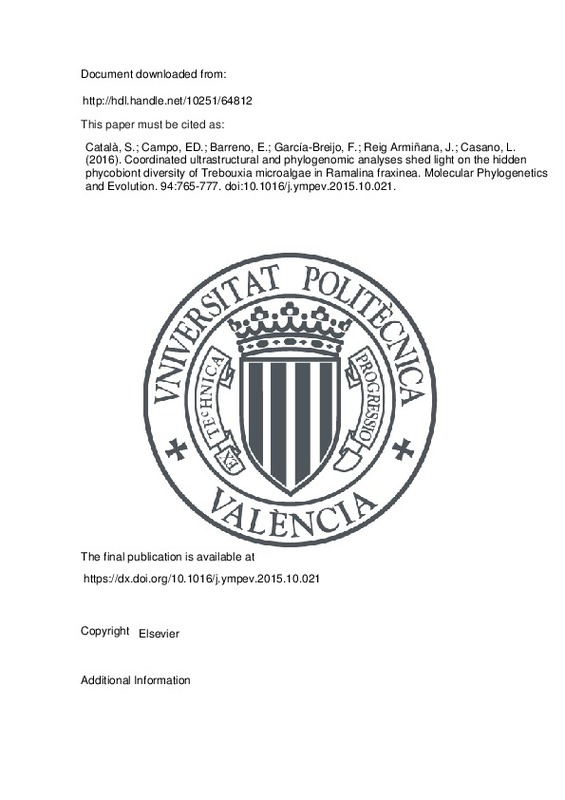JavaScript is disabled for your browser. Some features of this site may not work without it.
Buscar en RiuNet
Listar
Mi cuenta
Estadísticas
Ayuda RiuNet
Admin. UPV
Coordinated ultrastructural and phylogenomic analyses shed light on the hidden phycobiont diversity of Trebouxia microalgae in Ramalina fraxinea
Mostrar el registro sencillo del ítem
Ficheros en el ítem
| dc.contributor.author | Català, Santiago
|
es_ES |
| dc.contributor.author | Campo, Eva del
|
es_ES |
| dc.contributor.author | Barreno, Eva
|
es_ES |
| dc.contributor.author | García-Breijo, Francisco-José
|
es_ES |
| dc.contributor.author | Reig Armiñana, José
|
es_ES |
| dc.contributor.author | Casano, Leonardo
|
es_ES |
| dc.date.accessioned | 2016-05-26T13:09:11Z | |
| dc.date.available | 2016-05-26T13:09:11Z | |
| dc.date.issued | 2016-01 | |
| dc.identifier.issn | 1055-7903 | |
| dc.identifier.uri | http://hdl.handle.net/10251/64812 | |
| dc.description.abstract | [EN] The precise boundary delineations between taxa in symbiotic associations are very important for evolutionary and ecophysiological studies. Growing evidence indicates that in many cases, the use of either morphological characters or molecular markers results in diversity underestimation. In lichen symbioses. Trebouxia is the most common genus of lichen phycobionts, however, the diversity within this genus has been poorly studied and as such there is no clear species concept. This study constitutes a multifaceted approach incorporating aspects of ultrastructural characterization by TEM and phylogenomics to evaluate the morphological and genetic diversity of phycobionts within the sexually reproducing lichen Ramalina fraxinea in the context of Mediterranean and temperate populations. Results reveal an association with at least seven different Trebouxia lineages belonging to at least two species. T. decolorans and T. jamesii, and diverse combinations of such lineages coexisting within the same thallus depending on the analysed sample. Some of these lineages are shared by several other non-related lichen taxa. Our findings indicate the existence of a highly diverse assemblage of Trebouxia algae associating with R. fraxinea and suggest a possible incipient speciation within T. decolorans rendering a number of lineages or even actual species. This study stresses the importance of coordinated ultrastructural and molecular analyses to improve estimates of diversity and reveal the coexistence of more than one Trebouxia species within the same thallus. lt is also necessary to have clearer species delimitation criteria within the genus Trebouxia and microalgae in general. | es_ES |
| dc.description.sponsorship | This study was funded by the Ministerio de Economia y Competitividad (MINECO CGL2012-40058-0O2-01/02), FEDER, the Generalitat Valenciana (PROMETEOII2013/021, GVA) and the Direccion General de Universidades e Investigacion de la Consejeria de Educacion de la Comunidad de Madrid - Universidad de Alcala (CCG10-UAH/GEN-5904). Drs. Arantxa Matins and Patricia Moya (Universitat de Valencia) made helpful comments on the manuscript. | en_EN |
| dc.language | Inglés | es_ES |
| dc.publisher | Elsevier | es_ES |
| dc.relation.ispartof | Molecular Phylogenetics and Evolution | es_ES |
| dc.rights | Reserva de todos los derechos | es_ES |
| dc.subject | Coexistence, cryptic species | es_ES |
| dc.subject | Lichen | es_ES |
| dc.subject | Ramalina | es_ES |
| dc.subject | Symbiosis | es_ES |
| dc.subject | Trebouxia | es_ES |
| dc.subject.classification | BOTANICA | es_ES |
| dc.subject.classification | PRODUCCION VEGETAL | es_ES |
| dc.subject.classification | BIOLOGIA VEGETAL | es_ES |
| dc.title | Coordinated ultrastructural and phylogenomic analyses shed light on the hidden phycobiont diversity of Trebouxia microalgae in Ramalina fraxinea | es_ES |
| dc.type | Artículo | es_ES |
| dc.identifier.doi | 10.1016/j.ympev.2015.10.021 | |
| dc.relation.projectID | info:eu-repo/grantAgreement/MINECO//CGL2012-40058-C02-02/ES/COEXISTENCIA DE DIFERENTES MICROALGAS EN UN MISMO TALO: POSIBLES IMPLICACIONES SOBRE EL FUNCIONAMIENTO Y CAPACIDAD ADAPTATIVA DE LAS SIMBIOSIS LIQUENICAS/ | es_ES |
| dc.relation.projectID | info:eu-repo/grantAgreement/MINECO//CGL2012-40058-C02-01/ES/COEXISTENCIA DE DIFERENTES MICROALGAS EN UN MISMO TALO: POSIBLES IMPLICACIONES SOBRE EL FUNCIONAMIENTO Y CAPACIDAD ADAPTATIVA DE LAS SIMBIOSIS LIQUENICAS/ | es_ES |
| dc.relation.projectID | info:eu-repo/grantAgreement/GVA//PROMETEOII%2F2013%2F021/ES/Genoma de Trebouxia sp. TR9 como modelo de alga verde simbionte: caracterización, potencial metabólico y estructural. Implicaciones de la coexistencia con otros simbiontes en talos liquénicos y plantas soporte/ | es_ES |
| dc.relation.projectID | info:eu-repo/grantAgreement/CAM//CCG10-UAH%2FGEN-5904/ | es_ES |
| dc.rights.accessRights | Abierto | es_ES |
| dc.contributor.affiliation | Universitat Politècnica de València. Instituto Agroforestal Mediterráneo - Institut Agroforestal Mediterrani | es_ES |
| dc.contributor.affiliation | Universitat Politècnica de València. Departamento de Ecosistemas Agroforestales - Departament d'Ecosistemes Agroforestals | es_ES |
| dc.description.bibliographicCitation | Català, S.; Campo, ED.; Barreno, E.; García-Breijo, F.; Reig Armiñana, J.; Casano, L. (2016). Coordinated ultrastructural and phylogenomic analyses shed light on the hidden phycobiont diversity of Trebouxia microalgae in Ramalina fraxinea. Molecular Phylogenetics and Evolution. 94:765-777. https://doi.org/10.1016/j.ympev.2015.10.021 | es_ES |
| dc.description.accrualMethod | S | es_ES |
| dc.relation.publisherversion | https://dx.doi.org/10.1016/j.ympev.2015.10.021 | es_ES |
| dc.description.upvformatpinicio | 765 | es_ES |
| dc.description.upvformatpfin | 777 | es_ES |
| dc.type.version | info:eu-repo/semantics/publishedVersion | es_ES |
| dc.description.volume | 94 | es_ES |
| dc.relation.senia | 296462 | es_ES |
| dc.identifier.eissn | 1095-9513 | |
| dc.contributor.funder | Generalitat Valenciana | es_ES |
| dc.contributor.funder | Comunidad de Madrid | es_ES |
| dc.contributor.funder | Ministerio de Economía y Competitividad | es_ES |
| dc.contributor.funder | European Regional Development Fund | es_ES |







![[Cerrado]](/themes/UPV/images/candado.png)

